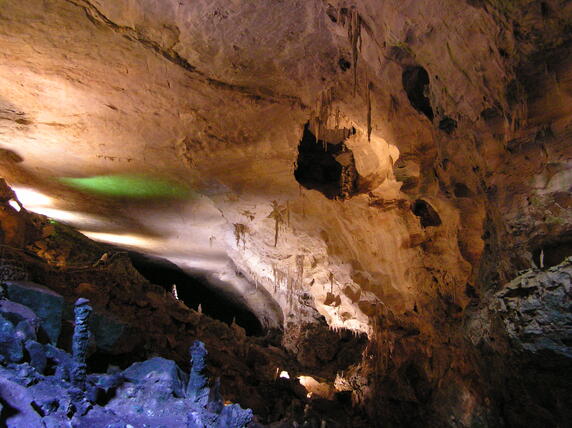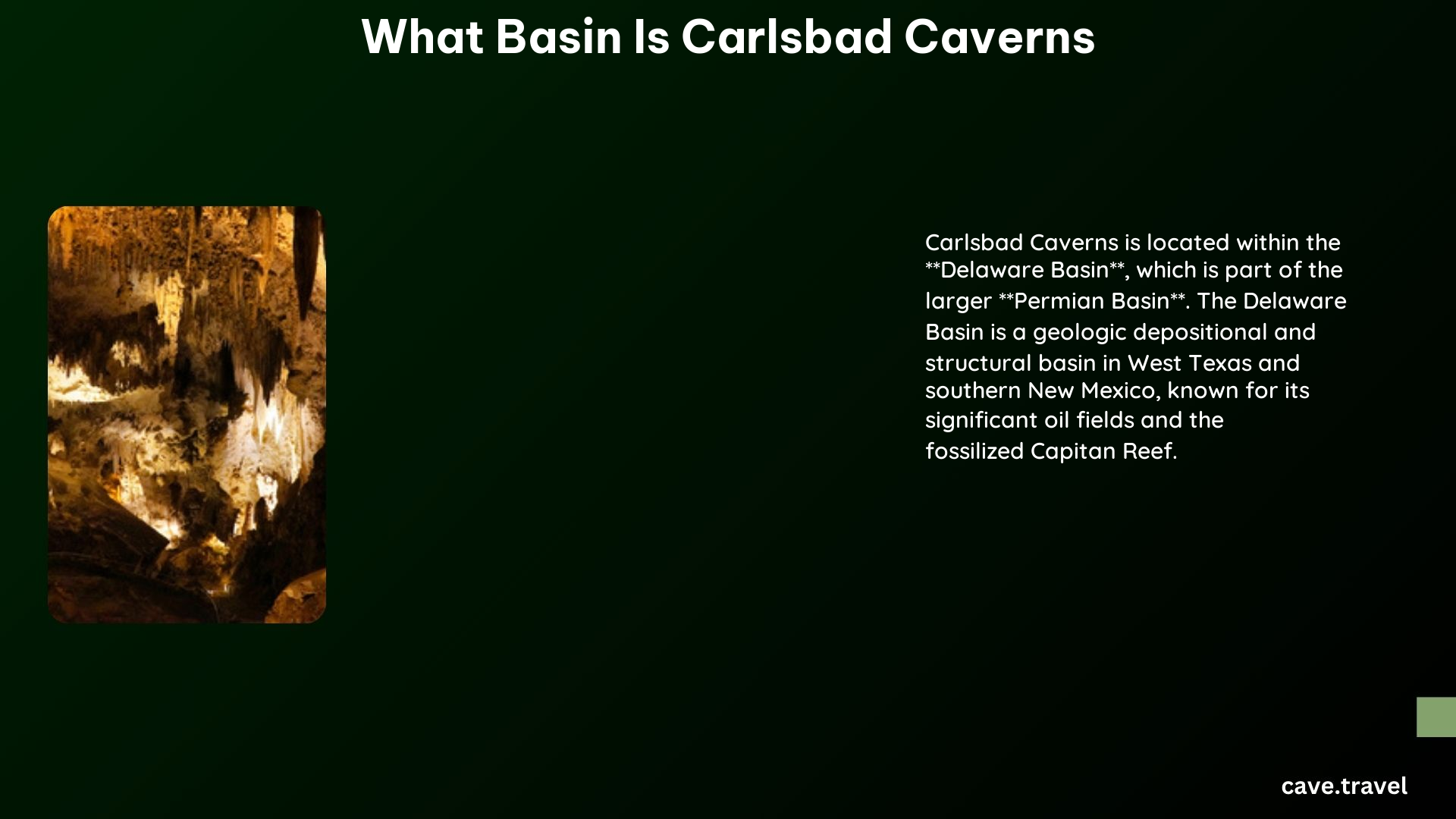Carlsbad Caverns is located in the Permian Basin, a vast geological region spanning southeastern New Mexico and western Texas. This underground wonder is part of the Guadalupe Mountains, formed from an ancient marine fossil reef. The caverns lie within the Chihuahuan Desert, showcasing a unique blend of surface and subterranean ecosystems. Understanding the basin context is crucial for appreciating the caverns’ geological significance and formation process.
What is the Geological Setting of Carlsbad Caverns?

The Permian Basin, home to Carlsbad Caverns, is a sedimentary basin that formed during the Permian Period, approximately 299 to 251 million years ago. This basin is characterized by:
- Extensive limestone deposits
- Ancient marine fossils
- Complex underground cave systems
The Guadalupe Mountains, where Carlsbad Caverns is situated, represent an uplifted portion of the Capitan Reef. This reef was once submerged beneath a shallow sea during the Permian Period. Over millions of years, geological processes have transformed this marine environment into the arid landscape we see today.
How Did the Permian Basin Influence Carlsbad Caverns’ Formation?

The unique geological history of the Permian Basin played a crucial role in the formation of Carlsbad Caverns:
- Reef Formation: During the Permian Period, a vast reef system developed in the shallow sea.
- Burial: As sea levels changed, the reef was buried under sediments.
- Uplift: Tectonic activity lifted the buried reef, exposing it to erosion.
- Cave Formation: Sulfuric acid, formed by the interaction of hydrogen sulfide from oil deposits and oxygen-rich groundwater, dissolved the limestone, creating the caverns.
- Speleothem Development: As water percolated through the limestone, it deposited minerals, forming stalactites, stalagmites, and other cave formations.
What Are the Key Features of the Permian Basin Around Carlsbad Caverns?
The Permian Basin surrounding Carlsbad Caverns exhibits several distinctive characteristics:
| Feature | Description |
|---|---|
| Topography | Rugged mountains and deep canyons |
| Climate | Arid to semi-arid with hot summers and mild winters |
| Vegetation | Desert scrub, cacti, and drought-resistant plants |
| Wildlife | Diverse species adapted to desert conditions |
| Geology | Limestone bedrock with extensive cave systems |
How Does the Basin’s Geology Affect the Cave Environment?
The Permian Basin’s geology significantly influences the cave environment at Carlsbad Caverns:
- Water Infiltration: The porous limestone allows water to seep through, contributing to cave formation and speleothem growth.
- Temperature Stability: The thick rock layers provide insulation, maintaining a constant cave temperature of around 56°F (13°C).
- Air Circulation: Natural openings in the limestone create air currents within the cave system.
- Mineral Diversity: The varied mineral composition of the basin’s rocks results in a wide array of colorful cave formations.
What Other Geological Wonders Exist in the Permian Basin Near Carlsbad Caverns?
The Permian Basin hosts several other geological marvels near Carlsbad Caverns:
- Lechuguilla Cave: One of the longest known caves in the world, famous for its unique gypsum and sulfur-based formations.
- Guadalupe Mountains National Park: Features Guadalupe Peak, the highest point in Texas, and showcases the ancient Capitan Reef.
- Delaware Basin: A sub-basin of the Permian, known for its oil and gas reserves.
- Gypsum Plains: Vast expanses of gypsum deposits creating a stark white landscape.
- Salt Basin Dunes: A field of white gypsum sand dunes, similar to those at White Sands National Park.
How Has the Basin’s Geology Impacted Human Activity in the Region?
The geological characteristics of the Permian Basin have significantly influenced human activities:
- Oil and Gas Exploration: The basin is one of the most productive oil and gas regions in the United States.
- Tourism: Geological wonders like Carlsbad Caverns attract millions of visitors annually.
- Agriculture: The arid climate and soil composition have shaped agricultural practices in the region.
- Water Management: The porous limestone affects groundwater dynamics, influencing water resource management.
What Scientific Research is Conducted in the Permian Basin Related to Carlsbad Caverns?
The unique geological setting of Carlsbad Caverns and the surrounding Permian Basin attracts various scientific studies:
- Speleology: Ongoing research into cave formation processes and unique cave ecosystems.
- Paleontology: Studies of fossilized marine life from the ancient Permian sea.
- Hydrology: Investigations into groundwater movement and its impact on cave formation.
- Climate Science: Analysis of cave deposits to understand past climate conditions.
- Microbiology: Exploration of extremophile organisms living in the cave environment.
How Does the Basin’s Geology Contribute to the Biodiversity of Carlsbad Caverns?
The geological features of the Permian Basin create diverse habitats that support a wide range of species:
- Cave Ecosystems: The limestone caverns provide a unique environment for cave-adapted species.
- Desert Adaptations: The arid surface conditions have led to specialized plant and animal adaptations.
- Bat Populations: The extensive cave systems offer ideal roosting sites for large bat colonies.
- Microhabitats: Varied surface topography creates microclimates supporting diverse flora and fauna.
What Conservation Efforts Address the Geological Aspects of Carlsbad Caverns?
Preserving the geological integrity of Carlsbad Caverns and the surrounding Permian Basin involves several conservation initiatives:
- Cave Microclimate Monitoring: Continuous tracking of temperature, humidity, and CO2 levels within the caves.
- Water Quality Protection: Measures to prevent contamination of groundwater that feeds the cave system.
- Surface Land Management: Controlled access to prevent erosion and damage to the fragile desert ecosystem.
- Educational Programs: Initiatives to raise awareness about the geological significance of the area.
- Research Partnerships: Collaboration with universities and scientific institutions to study and preserve the cave environment.
The Permian Basin, with its rich geological history and unique features, provides the perfect setting for natural wonders like Carlsbad Caverns. Understanding the basin’s context enhances our appreciation of these underground marvels and underscores the importance of preserving such geological treasures for future generations.
References:
1. Interesting Facts About Carlsbad Caverns – National Park Service
2. Carlsbad Caverns National Park – Wikipedia
3. Carlsbad Caverns and Guadalupe Mountains National Parks – Nature Track
